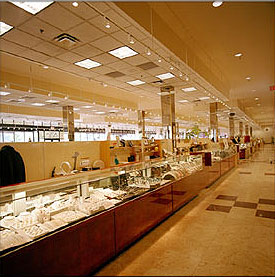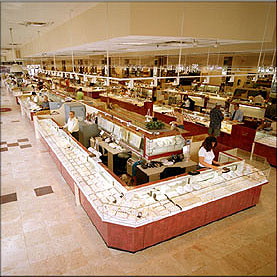The Jewelry Center has over one million pieces of jewelry on display. Lighting to expose the brilliance of fine diamonds and gemstones to our visitors. Forty-four (44) Independent Professional Jewelers who have the expertise and knowledge of precious stones to help guide you and satisfy your decision in the purchasing of fine jewelry. We have Gemological Custom Designers and Repair Shops on premise. They can satisfy sizing & repairs immediately and custom work with expedience. Their work is impeccable, as is their reputation.

We hope you enjoy the exciting experience of visiting THE JEWELRY CENTER

Engagement Rings & Wedding Bands
14-18-24 Karat White and Yellow Gold
Earrings
Diamond Studs
Lustrous Cultured, Fresh Water, Tahitian Pearls

Precious Stones and Gemstones
Designer Watches
Elegant Sterling Silver
Necklaces
Religious Jewelry
| The Gemological Institute of America | The International Gemological Institute | European Gemological Laboratories |
Here at The Jewelry Center in Paramus NJ each jeweler offers diamonds certificates and a full report about the diamond jewelry and it can be arranged and presented for your approval and review even before purchase. There are three links above to the best Gemological Institutes Worldwide. Reading over their Web sites will give you the knowledge of how to read and understand the reports and your certificate, which will assure you that you’ve made a good purchase in your stone(s) and jewelry. It is also necessary in obtaining Insurance, if you so desire. Below is our quick guide to the GIA 4 C’s of Diamonds.
The Jewelry Center is a very exciting experience and just remember this “Why shop for your jewelry in 4-5 locations when you can do it all here. Forty-four (44) expert jewelers in the Largest Jewelry Store in the World?”
Color Range: Normal
GIA Color Scale: DEF Colorless GHIJ Near Colorless KLM Faint Yellow NOPQR Very light
YellowSUVWXYZ Light Yellow Z+ Fancy
Diamond’s color is often misunderstood by the consumer. People assume diamonds to be colorless. But colorless diamonds are quite rare. Most diamonds used in jewelry are nearly colorless with faint yellow or brown tints which are diamonds that fall in the normal color range. D color diamonds will always be of more valuable than other diamonds, all other factors considered Clarity, Carat weight, Cut, and all being equal.
Diamonds outside the normal color range are called fancy-colored and come in many colors. Any naturally colored diamond with a noticeable depth of body color is considered to be rare or attractive. Red and green are the rarest fancy colors, then purple, violet, orange, blue, and pink. Yellow and greenish yellow diamonds are most common. White, black, and gray are spectral colors, and are also considered fancies. In the GIA color grading system, fancy color grades are described as faint, very light, light, fancy light, fancy, fancy intense, and fancy dark. Fine Color or little to no visible color, the greater the value.
Diamonds outside the normal color range are called fancy-colored and come in many colors. Any naturally colored diamond with a noticeable depth of body color is considered to be rare or attractive. Red and green are the rarest fancy colors, then purple, violet, orange, blue, and pink. Yellow and greenish yellow diamonds are most common. White, black, and gray are spectral colors, and are also considered fancies. In the GIA color grading system, fancy color grades are described as faint, very light, light, fancy light, fancy, fancy intense, and fancy dark. Fine Color or little to no visible color, the greater the value.
Clarity
Diamonds are not absolutely 100% perfect. Diamonds have internal features identified as inclusions, and surface irregularities known as blemishes. Combined they are labeled clarity characteristics. Clarity is the actual absence of clarity characteristics/internal inclusions and blemishes, scratches and nicks present on a diamond’s external inclusions surface. Clarity to be graded on a scale of flawless to included. Internal inclusions with visual appearance could break the surface of the diamond, but they are still considered inclusions. Inclusions inside a diamond or other mineral crystals are trapped in the early formation. Dependent on location they may or may not be there after the stone has been cut and polished.
GIA Clarity Scale:
(FL) Flawless: No visible inclusions or blemishes under 10X magnification, by an experienced grader.
(IF) Internally Flawless: No inclusions under 10X magnification by anexperienced grader. But will have some minor blemishes.
(VVS1and VVS2) Very Very Slightly Included: Has minute inclusions very difficult to observe under 10X magnification by the experienced grader.
(VS1and VS2) Very Slightly Included: Contains minute inclusions that are diffult to see by an experienced grader under 10X magnification.
(SI1 and SI2) Slightly Included: Contains inclusions clouds, included crystals, or feathers when observed with effort under 10X magnification.
(I1, I2, I3) Included: Contains inclusions (possibly large feathers or large included crystals) that are obvious under 10X magnification and may affect transparency and brilliance.
Cut
The most complex of the Four Cs
Cut is the shape and style of a polished diamond. There are standard rounds, brilliants are called fancy shapes or fancy cuts. Best known are the heart, marquise, pear-shaped cut, emerald-cut, oval, and radiant.
Cut has a value factor determined by the proportions, symmetry and finish of a diamond, trade name “make”. Diamonds with a “good make” will be bright, fiery, symmetrical, and sparkles with light.”
The three major components of a polished diamond are from top to bottom, and they are the crown, the girdle, and the pavilion. Polished diamonds have a very tiny flat facet at the bottom of the pavilion, known as the culet. The flat facet at the top of a polished diamond is called the table.”
The “Per Carat” Concept
One metric carat is just over seven thousandths (0.007) of an ounce. Diamond weights are identified as metric carats, abbreviated “ct.” One ounce contains almost 142 carats. Metric carat is divided into 100 points. A point is 1/100 of a carat . Just like dollars and cents. And are written exactly that way. Carat first, then a decimal point, and then the points: $1.97 means one dollar and 97 cents, while 1.97-ct. means one carat and 97 points.
A well-cut diamond directs more light through the crown. Diamonds are weighed to a thousandth (0.001) of a carat and then rounded to the nearest hundredth, or point. Diamonds over a carat, the diamond weights are usually expressed in carats and decimals. A 1.09 ct. stone would be described as “one point oh nine carats,” or “one oh nine.” Diamonds that weighs 0.97 ct. is said to weigh “ninety seven points,” or a “ninety seven pointer.”
It’s really a simple concept: Large diamonds are rarer than small diamonds. The scarcer a diamond is, the higher its worth.
